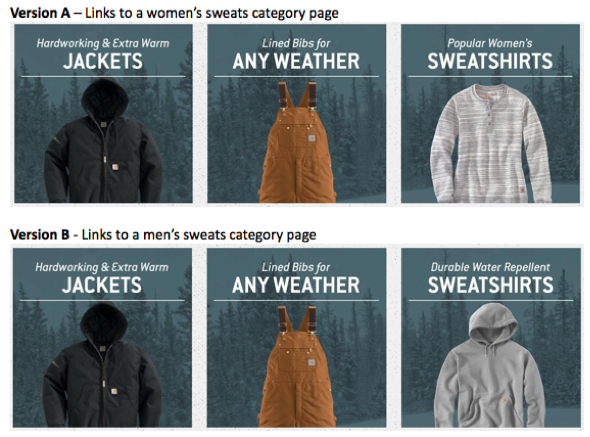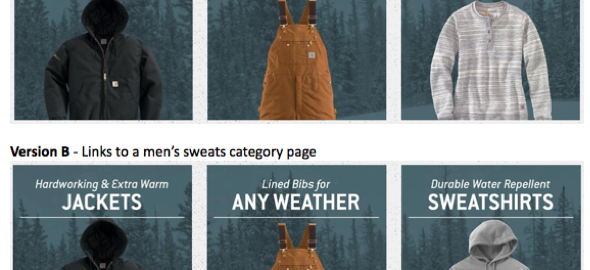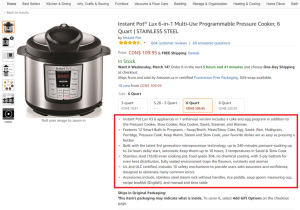— March 1, 2019

Planning for any kind of business initiative can be difficult. You have a clear vision of your end goal, but what do you need to do to get there? Executing personalization in your organization is no different. Personalization can have a tremendous impact on your business, but it can be overwhelming to think about how to get to your end goal: delivering relevant experiences to your customers – across channels – to improve engagement, conversions and loyalty.
Strategy
The best way to approach personalization is to first have a strategy. You can certainly launch a campaign or two without a clear strategy initially (such as sending out a few personalized emails, adding product recommendations to your cart page, etc.), but ultimately you should aim to work toward the bigger picture.
Each company will approach its personalization strategy in its own way, but if you’re struggling for a place to start, begin by outlining your why’s, who’s, where’s and what’s.
Why
Why do you want to personalize in the first place? What are you trying to accomplish? Start by answering this question at the broadest level by outlining your general goals for personalization. Do you want to increase conversions? Improve engagement? Increase average order size? Decrease bounce rates? Drive more leads? Increase retention or loyalty? These high-level goals will likely align with your general marketing or even your overall business goals — so they should already be top-of-mind for you.
Once you’ve thought about your goals for personalization in general, consider your specific and measurable goals for this year or even this quarter. For example, maybe you want to increase email sign-ups by 5% or increase repeat buyers by 30%. When you’re clear about what your measurable goals are, you’ll be able to chart the course for using personalization to get there.
Who
Next, consider your audience — the “who.” What types of people do you want to speak differently to? Prospects and customers? Loyal shoppers and first-time visitors? Visitors from target accounts or target industries? Visitors with different demographics or locations? Think through who your visitors are and what meaningful differences exist between them — that will be the basis of your segmentation and rule-based campaigns.
Then think about the differences between individuals. Each person has his own preferences for brands, categories, topics, colors, prices, authors, etc. Each person is also at a different stage of the funnel and each will respond differently to various promotions. Think about those types of differences — they will be the basis of your 1-to-1 machine learning-driven campaigns.
Where
Next, consider where you plan to leverage personalization. Start by thinking broadly about the channels you currently use to interact with customers. Your website? Mobile app? Emails? In your store? Branch location? Any channel where you regularly communicate is a likely candidate for personalization.
Once you’ve thought about that, you can get a little more granular and start thinking about different points of interaction. Retailers have their homepages, PDPs, category pages, cart pages, triggered emails, newsletter emails, etc. Technology or finance companies have their homepages, blog pages, landing pages, forms, salespeople, newsletter emails, event promotion emails, etc.
Deciding which aspects of the buyer’s experience you’d like to personalize will help you get on the right track going forward.
What
Finally, think about what you want to say to the people you identified in the channels you identified to accomplish the objectives you identified.
For example, do you want to recommend content or products? Categories or brands? Do you want to personalize the navigation or search results? Do you want to select the right promotion or offer for each person? Do you want to promote events to specific geolocations or webinars to people with specific interests? Think broadly about the types of experiences you’d like to deliver and start making a list.
Execution
Once you’ve worked out the why’s, who’s, where’s and what’s of your strategy, you can turn your attention to execution. For each campaign, make sure you can understand, decide, engage and measure.
Understand
Before you can deliver any relevant experience to anyone, you have to understand what’s relevant to that person. In the digital world, that understanding is achieved with data. For each campaign, identify which data sources you need to effectively identify the experience that works best for each person.
If you’re planning to promote an event to website visitors within a certain region, for instance, you need to be able to identify each person’s geolocation. But if you want to deliver product recommendations individually tailored to each person’s tastes in categories, brands and colors, you’ll need to be able to track in-depth behavioral data.
Decide
Next, each personalization campaign needs to be able to decide what to show or change for the target audience members. This is done using rules or algorithms. Rules are manual — you decide which experience to deliver to which group of people. With algorithms, you put the decision in the hands of a machine (according to your parameters) to sift through all the data available to pick the best option for each person. You’ll want to use rules, algorithms or, most likely, a combination of both in your campaigns.
Engage
Once a decision about what personalized experience to deliver is made, the campaign then needs to instantly engage the target audience. This is where everything comes together. Make sure you find a solution that allows you to configure your campaigns to suit your specific needs for each campaign. You’ll want to be able to ensure you’re reaching the right group or individual with the right creative in a given channel – all in real time.
Measure
Finally, you’ll want to measure the impact of each campaign. Ideally, you should set up a control and a test experience so that you can identify if a campaign drives lift in your key metrics. You’ll want to look at a few different metrics for most campaigns. Clickthroughs, conversions, average order value, bounce rate, email subscriptions, time on site, articles read, etc. are all common metrics to measure.
Example: Category Recommendations
Finally, let’s look at a quick example. As one of its many personalization campaigns, retailer Carhartt opted to display recommendations for product categories on its homepage.
With this campaign, the categories a person sees vary based on their specific preferences, as in this example:

Let’s explore the strategy and execution of this specific campaign:
Strategy:
- Why: Increase number of cross-category purchasers. Carhartt shoppers tend to be creatures of habit who buy the same products over and over again. Carhartt was looking to encourage shoppers to explore more categories.
- Who: All shoppers, with a specific focus on cross-category shoppers and shoppers who have purchased only one category.
- Where: Homepage.
- What: Category banners (see image above).
Execution:
- Understand: To execute this campaign, Carhartt needed to be able to understand visitor and customer category-level behavior and purchases.
- Decide: Carhartt decided to set up an algorithm to deliver machine learning-driven recommendations at the category level.
- Engage: Carhartt launched this campaign on its website via Evergage’s personalization and customer data platform.
- KPIs: Clickthroughs, purchases, average order value, and revenue per visitor.
Final Thoughts
Delivering successful personalized experiences hinges on your ability to set a solid strategy and execute it well. To learn more about how to accomplish this, watch the full webinar replay.
Business & Finance Articles on Business 2 Community
(78)
Report Post








